#joint support and enabling command
Explore tagged Tumblr posts
Text
Qunol Turmeric Curcumin: Extra Strength Joint Support, 1500mg, 2-Month Supply

Qunol Turmeric Curcumin offers a potent 1500mg dose of ultra-high absorption turmeric for enhanced joint support and overall wellness. These extra-strength capsules are designed to provide effective relief and support for your joints, with a convenient 2-month supply to ensure sustained benefits. Experience the power of advanced turmeric formulation for optimal health and vitality
Get joint support now
#joint support#joint support supplements#nveda joint support#joint support for dogs#joint support sweet relief#joint support by earth energy#sweet relief joint support reviews#pupgrade joint support#solgar 7 joint support#oxbow joint support#pure health joint support#joint support amazon#joint support and enabling command#joint support amino asylum#joint support advanced#joint support adalah#joint support amway#joint support advanced herbalife#joint supports a proposal#joint service achievement medal#optimum nutrition joint support
1 note
·
View note
Text

The F-16 Will Be Equipped with the AGM-158C LRASM
NAVAIR is looking to award a contract for the integration of the AGM-158C-1 Long-Range Anti-Ship Missile (LRASM) on the F-16.
Stefano D'Urso
F-16 LRASM
The Naval Air Systems Command (NAVAIR) released on Mar. 17, 2025, a presolicitation to negotiate a contract with Lockheed Martin for the integration and test support of the AGM-158C-1 Long-Range Anti-Ship Missile (LRASM) on the F-16. This development follows the recent news of a new contract to Lockheed Martin to increase the production of the JASSM (Joint Air-to-Surface Standoff Missile) and LRASM.
NAVAIR is looking to award a contract for the integration of the AGM-158C-1 Long-Range Anti-Ship Missile (LRASM) on the F-16.The AGM-158 production increaseThe LRASM
The notice mentions that NAVAIR “intends to enter into sole source negotiations and subsequently award a Cost-Plus Fixed Fee (CPFF) Delivery Order (DO) to Lockheed Martin Corporation-Missiles Fire Control.” Also, the notice mentions that the “requirement includes testing both the AGM-158C-1 Legacy and UAI interfaces.”
The UAI, or Universal Armament Interface, is the result of a U.S. Department of Defense program to develop standardized functional interfaces in both aircraft and weapons to support a rapid integration of new weapons independent of an aircraft’s Operational Flight Program (OFP) cycles. The F-16 and JASSM were already tested with the new interface.
NAVAIR has not released additional details about the integration of LRASM on the F-16 at this time, although we might have more info after the response day planned for Apr. 1. Earlier this month, Lockheed Martin and the F-35 Pax River Integrated Test Force (ITF) disclosed that the F-35B Lightning II started flight testing as part of the integration with LRASM.

U.S. Air Force Tech. Sgt. Peter Giesige and Airman 1st Class Brian Bowser, both weapons specialists assigned to the Ohio National Guard’s 180th Fighter Wing, and Staff Sgt. Katelyn Barrow, a munitions specialist also assigned to the 180FW, successfully load a JASSM AGM-158 on to a F-16 Fighting Falcon during an Agile Combat Employment stress test in Swanton, Ohio, Sept. 12, 2024. (U.S. Air Force photo by Airman 1st Class Camren Ray)
The AGM-158 production increase
On Mar. 14, 2025, Lockheed Martin Missiles and Fire Control has been awarded a $122,6 million contract modification to the original production increase’s contract awarded in 2018. As part of the contract, the company will “procure tooling and test equipment needed to increase production quantities of Joint Air-to-Surface Standoff Missile and Long-Range Anti-Ship Missile.”
Lockheed Martin has been investing in the increase of the AGM-158’s production since 2022, when it added a new 225,000-square-foot factory to its existing production facilities. In 2024, another contract modification was awarded to “enable the ability to increase annual production quantities by providing additional resources for long-lead procurements and facilitating production line efficiencies.”
In the fiscal year 2025 budget the U.S. Air Force requested 550 JASSMs, after the same number was also requested in 2024 and 600 were requested in 2023. The Air Force budget requested for its own and the Navy’s stocks 115 LRASMs in FY2025, 27 in FY2024 and 57 in FY2023.

An F-35 Lightning II test pilot conducts flight test Sept. 9 to certify the carrier variant of the fighter aircraft for carrying the AGM-158C Long-Range Anti-Ship Missile (LRASM). (Image credit: Dane Wiedmann).
The LRASM
The AGM-158C LRASM, based on the AGM-158B Joint Air-to-Surface Standoff Missile – Extended Range (JASSM-ER), is the new low-observable anti-ship cruise missile developed by DARPA (Defense Advanced Research Projects Agency) for the U.S. Air Force and U.S. Navy. NAVAIR describes the weapon as a defined near-term solution for the Offensive Anti-Surface Warfare (OASuW) air-launch capability gap that will provide flexible, long-range, advanced, anti-surface capability against high-threat maritime targets.
NAVAIR says the weapon reduces dependency on Intelligence, Surveillance and Reconnaissance (ISR) platforms, network links, and GPS navigation in electronic warfare environments. In fact, once launched, LRASM guides to an initial point using a GPS guidance system and employs onboard sensors to locate, identify, and provide terminal guidance to the target. Semi-autonomous guidance algorithms will allow it to use less-precise target cueing data to pinpoint specific targets in the contested domain.
There are currently three variants which comprise the OASuW Increment 1 program, designated LRASM 1.0, LRASM 1.1, and LRASM C-3. The LRASM 1.0 variant, which was fielded with early operational capability in 2019, has already been integrated on the B-1B Lancer and F/A-18E/F Super Hornet.

An F-35 Lightning II test pilot conducts the first flight test to certify the F-35B short takeoff and vertical landing variant of the fighter aircraft for carrying the AGM-158C Long-Range Anti-Ship Missile (LRASM). (Image credit: Kyra Helwick)
The newer LRASM 1.1 variant was fielded in 2023 and is undergoing Initial Operational Test & Evaluation, according to the Director, Operational Test and Evaluation’s report. The weapon is also being integrated on the P-8A Poseidon, with the activities expected to be completed by Summer 2024, although no updates about the status were released.
As for the future LRASM C-3, which adds extended range capability, the program planned a land strike capability was part of the LRASM C-3 upgrade but has since decided to remain focused on surface warfare capabilities. The missile concept of operations and system requirements were completed last year, focusing on anti-surface warfare employment range and updating the missile target threat library compared to LRASM 1.1.
The Navy has scheduled LRASM C-3 early operational capability (EOC) for 4QFY26. Meanwhile, the Department of Defense continues to plan for OASuW Increment 2 to be developed via full and open competition, with EOC anticipated in FY29 and initial operational capability anticipated in FY31. The Navy funded LRASM C-3 to bridge the gap until an OASuW Increment 2 program of record is established.
LRASM

File photo of an F/A-18F Super Hornet launching an AGM-158C LRASM during a test event in 2019. (Photo: NAVAIR)
In January 2025, NAVAIR disclosed that the U.S. Air Force’s F-15E Strike Eagle and F-15EX Eagle IIs are now set to be armed with the LRASM. Similarly to the F-16, the F-15E/EX has already been tested with the similar JASSM and the UAI.
In September 2024, an F-35C test aircraft from Naval Air Station (NAS) Patuxent River, Maryland, conducted the first test flights for the integration of the AGM-158, both in the JASSM and LRASM variants. In January 2025, the same testing was also conducted with the F-35B.
@TheAviationist.com
21 notes
·
View notes
Text
If the tables were turned, if a Democratic president were ignoring the Supreme Court and disappearing right-wing activists, we would be in the middle of a civil war right now. There would have been zero hesitation from red states to formally unite and declare themselves the "legitimate" government (they wouldn't secede, they would say that the president and his enablers in Congress were rogue and lead an internal fight against them). World leaders would currently be taking sides, there would be a Wikipedia article about the constitutional crisis and competing claims to the presidency, competing claims to the nuclear chain of command, the joint chiefs would coup and march on the White House. But that's not where we're at, and we never will be. Blue states will never unite, they will never petition our allies for support against the regime, they will never openly rebel against the system; instead they will slowly fall to fascism, one by one, accepting the state of affairs and offering nominal opposition until they've been shut out completely. "We do not agree with what is happening, so you need to get out and vote to stop it! Oh, the fascists won the vote? They flipped the state houses and are enshrining their power forever? Well, maybe they'll let us try again in two years and you can vote even harder!"
#us politics#this does not end well#this does not end soon#this is not going to be solved in 2026 or 2028#this is an ongoing national crisis but the media will never address it as such#historians will argue over specifics but 2025 marks the end of one era and the beginning of another#antebellum era#the civil war#reconstruction#jim crow#the civil rights movement#the cold war#the brief ''peace'' between the gulf war and 9/11#the war on terror#2008 and 2016 were turning points#as was 2020 with the pandemic#but 2025 will be THE year historians point to#like 1914 and 1933 and 1939 and 1945 and 1969 and 1981 and 2001 etc.
15 notes
·
View notes
Text
Jaegers of Pacific Rim: What do we know about them?
There's actually a fair amount of lore about Pacific Rim's jaegers, though most of it isn't actually in the movie itself. A lot of it has been scattered in places like Pacific Rim: Man, Machines, & Monsters, Tales From Year Zero, Travis Beacham's blog, and the Pacific Rim novelization.
Note that I will not be including information from either Pacific Rim: Uprising or Pacific Rim: The Black. Uprising didn't really add anything, and The Black's take on jaegers can easily be summed up as "simplified the concept to make a cartoon for children."
So what is there to know about jaegers, besides the fact that they're piloted by two people with their brains connected via computer?
Here's a fun fact: underneath the hull (which may or may not be pure iron), jaegers have "muscle strands" and liquid data transfer technology. Tendo Choi refers to them in the film when describing Lady Danger's repairs and upgrades:
Solid iron hull, no alloys. Forty engine blocks per muscle strand. Hyper-torque driver for every limb and a new fluid synapse system.
The novelization by Alex Irvine makes frequent references to this liquid data transfer tech. For example:
The Jaeger’s joints squealed and began to freeze up from loss of lubricant through the holes Knifehead had torn in it. Its liquid-circuit neural architecture was misfiring like crazy. (Page 29.)
He had enough fiber-optic and fluid-core cabling to get the bandwidth he needed. (Page 94.)
Newt soldered together a series of leads using the copper contact pins and short fluid-core cables. (Page 96.)
Unfortunately I haven't found anything more about the "muscle strands" and what they might be made of, but I do find it interesting that jaegers apparently have some sort of artificial muscle system going on, especially considering Newt's personnel dossier in the novel mentioned him pioneering research in artificial tissue replication at MIT.
The novelization also mentions that the pilots' drivesuits have a kind of recording device for their experiences while drifting:
This armored outer layer included a Drift recorder that automatically preserved sensory impressions. (Page 16.)
It was connected through a silver half-torus that looked like a travel pillow but was in fact a four-dimensional quantum recorder that would provide a full record of the Drift. (Page 96.)
This is certainly... quite the concept. Perhaps the PPDC has legitimate reasons for looking through the memories and feelings of their pilots, but let's not pretend this doesn't enable horrific levels of privacy invasion.
I must note, though, I haven't seen mention of a recording system anywhere outside of the novel. Travis Beacham doesn't mention it on his blog, and it never comes up in either Tales From Year Zero or Tales From The Drift, both written by him. Whether there just wasn't any occasion to mention it or whether this piece of worldbuilding fell by the wayside in Beacham's mind is currently impossible to determine.
Speaking of the drivesuits, let's talk about those more. The novelization includes a few paragraphs outlining how the pilots' drivesuits work. It's a two-layer deal:
The first layer, the circuity suit, was like a wetsuit threaded with a mesh of synaptic processors. The pattern of processor relays looked like circuitry on the outside of the suit, gleaming gold against its smooth black polymer material. These artificial synapses transmitted commands to the Jaeger’s motor systems as fast as the pilot’s brain could generate them, with lag times close to zero. The synaptic processor array also transmitted pain signals to the pilots when their Jaeger was damaged.
...
The second layer was a sealed polycarbonate shell with full life support and magnetic interfaces at spine, feet, and all major limb joints. It relayed neural signals both incoming and outgoing. This armored outer layer included a Drift recorder that automatically preserved sensory impressions.
...
The outer armored layer of the drivesuit also kept pilots locked into the Conn-Pod’s Pilot Motion Rig, a command platform with geared locks for the Rangers’ boots, cabled extensors that attached to each suit gauntlet, and a full-spectrum neural transference plate, called the feedback cradle, that locked from the Motion Rig to the spine of each Ranger’s suit. At the front of the motion rig stood a command console, but most of a Ranger’s commands were issued either by voice or through interaction with the holographic heads-up display projected into the space in front of the pilots’ faces. (Page 16.)
Now let's talk about the pons system. According to the novelization:
The basics of the Pons were simple. You needed an interface on each end, so neuro signals from the two brains could reach the central bridge. You needed a processor capable of organizing and merging the two sets of signals. You needed an output so the data generated by the Drift could be recorded, monitored, and analyzed. That was it. (Page 96.)
This is pretty consistent with other depictions of the drift, recording device aside. (Again, the 4D quantum recorder never comes up anywhere outside of the novel.)
The development of the pons system as we know it is depicted in Tales From Year Zero, which goes into further detail on what happened after Trespasser's attack on San Francisco. In this comic, a jaeger can be difficult to move if improbably calibrated. Stacker Pentecost testing out a single arm describes the experience as feeling like his hand is stuck in wet concrete; Doctor Caitlin Lightcap explains that it's resistance from the datastream because the interface isn't calibrated to Pentecost's neural profile. (I'm guessing that this is the kind of calibration the film refers to when Tendo Choi calls out Lady Danger's left and right hemispheres being calibrated.)
According to Travis Beacham's blog, solo piloting a jaeger for a short time is possible, though highly risky. While it won't cause lasting damage if the pilot survives the encounter, the neural overload that accumulates the longer a pilot goes on can be deadly. In this post he says:
It won't kill you right away. May take five minutes. May take twenty. No telling. But it gets more difficult the longer you try. And at some point it catches up with you. You won't last a whole fight start-to-finish. Stacker and Raleigh managed to get it done and unplug before hitting that wall.
In this post he says:
It starts off fine, but it's a steep curve from fine to dead. Most people can last five minutes. Far fewer can last thirty. Nobody can last a whole fight.
Next, let's talk about the size and weight of jaegers. Pacific Rim: Man, Machines, & Monsters lists off the sizes and weights of various jaegers. The heights of the jaegers it lists (which, to be clear, are not all of them) range from 224 feet to 280 feet. Their weights range from 1850 tons to 7890 tons. Worth noting, the heaviest jaegers (Romeo Blue and Horizon Brave) were among the Mark-1s, and it seems that these heavy builds didn't last long given that another Mark-1, Coyote Tango, weighed 2312 tons.
And on the topic of jaeger specs, each jaeger in Pacific Rim: Man, Machines, & Monsters is listed with a (fictional) power core and operating system. For example, Crimson Typhoon is powered by the Midnight Orb 9 power core, and runs on the Tri-Sun Plasma Gate OS.
Where the novelization's combat asset dossiers covers the same jaegers, this information lines up - with the exception of Lady Danger. PR:MMM says that Lady Danger's OS is Blue Spark 4.1; the novelization's dossier says it's BLPK 4.1.
PR:MMM also seems to have an incomplete list of the jaegers' armaments; for example, it lists the I-22 Plasmacaster under Weaponry, and "jet kick" under Power Moves. Meanwhile, the novelization presents its armaments thus:
I-22 Plasmacaster Twin Fist gripping claws, left arm only Enhanced balance systems and leg-integral Thrust Kickers Enhanced combat-strike armature on all limbs
The novel's dossiers list between 2-4 features in the jaegers' armaments sections.
Now let's move on to jaeger power cores. As many of you probably already know, Mark-1-3 jaegers were outfitted with nuclear power cores. However, this posed a risk of cancer for pilots, especially during the early days. To combat this, pilots were given the (fictional) anti-radiation drug, Metharocin. (We see Stacker Pentecost take Metharocin in the film.)
The Mark-4s and beyond were fitted with alternative fuel sources, although their exact nature isn't always clear. Striker Eureka's XIG supercell chamber implies some sort of giant cell batteries, but it's a little harder to guess what Crimson Typhoon's Midnight Orb 9 might be, aside from round.
Back on the topic of nuclear cores, though, the novelization contains a little paragraph about the inventor of Lady Danger's power core, which I found entertaining:
The old nuclear vortex turbine lifted away from the reactor housing. The reactor itself was a proprietary design, brainchild of an engineer who left Westinghouse when they wouldn’t let him use his lab to explore portable nuclear miniaturization tech. He’d landed with one of the contractors the PPDC brought in at its founding, and his small reactors powered many of the first three generations of Jaegers. (Page 182.)
Like... I have literally just met this character, and I love him. I want him to meet Newt Geiszler, you know? >:3
Apparently, escape pods were a new feature to Mark-3 jaegers. Text in the novelization says, "New to the Mark III is an automated escape-pod system capable of ejecting each Ranger individually." (Page 240.)
Finally, jaegers were always meant to be more than just machines. Their designs and movements were meant to convey personality and character. Pacific Rim: Man, Machines, & Monsters says:
Del Toro insisted the Jaegers be characters in and of themselves, not simply giant versions of their pilots. Del Toro told his designers, "It should be as painful for you to see a Jaeger get injured as it is for you to see the pilot [get hurt.]" (Page 56.)
Their weathered skins are inspired by combat-worn vehicles from the Iraq War and World War II battleships and bombers. They look believable and their design echoes human anatomy, but only to a point. "At the end of the day, what you want is for them to look cool," says Francisco Ruiz Velasco. "It's a summer movie, so you want to see some eye candy." Del Toro replies, "I, however, believe in 'eye protein,' which is high-end design with a high narrative content." (Page 57.)
THE JAEGER FROM DOWN UNDER is the only Mark 5, the most modern and best all-around athlete of the Jaegers. He's also the most brutal of the Jaeger force. Del Toro calls him "sort of brawler, like a bar fighter." (Page 64.)
And that is about all the info I could scrounge up and summarize in a post. I think there's a lot of interesting stuff here - like, I feel that the liquid circuit and muscle tissue stuff gives jaegers an eerily organic quality that could be played for some pretty interesting angles. And I also find it interesting that jaegers were meant to embody their own sort of character and personality, rather than just being simple combat machines or extensions of their pilots - it's a great example of a piece of media choosing thematic correctness over technical correctness, which when you get right down to it, is sort of what Pacific Rim is really all about.
106 notes
·
View notes
Text

Virtu fighting against automatons during a daring mission. The corpo robotics facility may have been temporarily dismantled but there are many more. This is just one successful mission out of an entire campaign.
Resistance Mission Overview: Tactical Report
Subject: Resistance War Efforts Under Command of Virtu
Location: Detroit Mega City (DMC)
Objective: Overthrow the corporate control of the automaton overlords, dismantle their infrastructure, and restore human autonomy.
Report Compiled by: Resistance Intelligence Division
Mission 1: [classified]
Mission 2: Coalition Building – Uniting the Marginalized Factions
Objective:
Form alliances with rogue factions, disenfranchised workers, and independent resistance groups to form a unified front capable of directly challenging the corpo forces. These groups will provide manpower, logistical support, and intelligence to the larger resistance movement.
Requirements for Success:
1. Primary Goal:
- Identify key marginalized factions across DMC: the Runners (informal hackers), the Underdweller (sewer and underground communities), and the Scavengers (waste reclamation crews).
- Secure communication channels with these factions, initially by leveraging covert operatives and establishing safe houses in neutral zones.
- Develop a framework for mutual cooperation, ensuring the independence of each faction while consolidating efforts towards a singular resistance goal.
2. Secondary Goal:
- Ensure shared resources are available to all factions, such as weapon caches, medical supplies, and data access points, to enable sustained resistance operations.
- Establish an underground network of hidden routes and transportation hubs for rapid mobilization and evacuation during emergencies.
3. Measurable Success Criteria:
- At least 40% of the target factions pledge formal allegiance to the resistance cause, agreeing to share resources and intelligence.
- The coalition is able to successfully carry out joint operations, such as the sabotage of supply lines or ambushes of key corpo patrols, without prior detection.
- A unified resistance force emerges capable of resisting corpo counterattacks in key sectors of the city.
#oc#oc art#detroit become human#cyberpunk#corpo#robot#robots#missions#apocalypse#apocalyptic fiction#fiction#my ocs#oc artwork#lore dump#lore drop#original character#gamedev#rpg
6 notes
·
View notes
Text


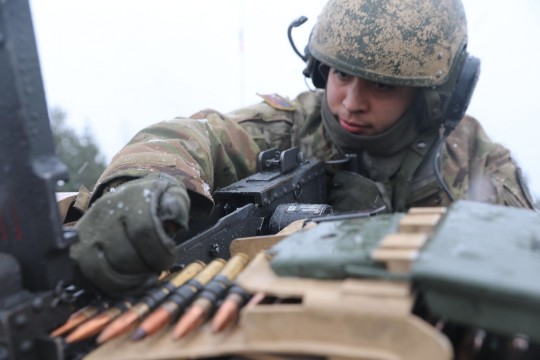
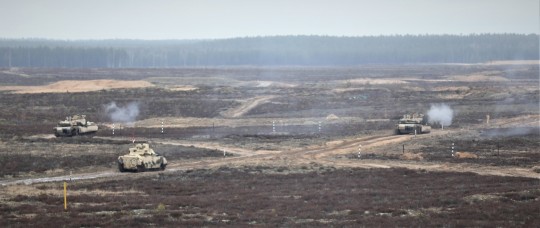


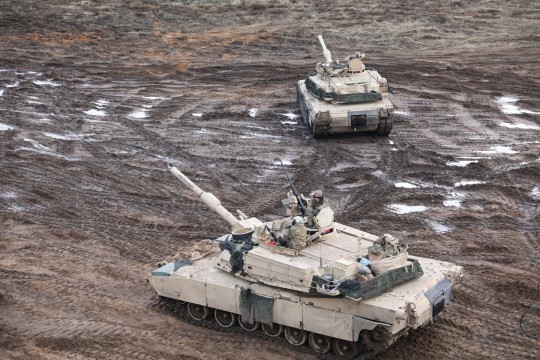
Soldiers with the 1st Battalion, 9th Cavalry Regiment from Fort Hood, Texas and multinational partner forces engage in a Combined Arms Live Fire Exercise (CALFEX) that was attended by the U.S. Emassador to Lithuania, Robert Gilchrist, on Feb. 12, 202… (Photo Credit: U.S. Army)
PABRADE, Lithuania - Soldiers with 1st Battalion, 9th U.S. Cavalry Regiment from Fort Hood, Texas, working side by side with multinational and allied forces, concluded their Combined Arms Live Fire Exercise training Feb 13, 2020.
Dutch artillery, Croatian mortar, Lithuanian and Norwegian fire support and the Baltic Air Police were some of the major assets involved in the execution of this enormous military exercise.
"A successful CALFEX is when my company commander walks out of here with a standard operating procedure and every single one of my leaders, whether it's a tank commander, a Bradley commander, a squad leader, a team leader…They walk out of here understanding their SOP's, having codified the lessons that they've learned throughout the entire train-up," said Lt. Col. Stephen Johnson, commander of the 1-9 CAV.
This large scale combined exercise involved assets from across the entire battlefield spectrum operating in a seamless, synchronous fashion.
Mortar teams working cooperatively were no exception.
"The goal for mortars here is to enable the maneuver elements in the company CALFEX to be able to get onto their objectives with ease," said 1st Lt. Alexander Shuler, a 1-9 CAV mortar platoon leader. "The thing that's really cool about working with the European nations, including Croatia, is that they're so used to working with other nations. A large part of us coming here to Europe is building upon that interoperability."
Indeed, Croatian Soldiers were an essential component of the mortar exercises as they worked closely with 1-9 CAV Soldiers throughout the CALFEX.
"The non-commissioned officers that we work closely with were really helpful," said 2nd Lt. Ante Validzic, with the 3rd mechanized infantry of the Croatian Land Forces. "They assisted us with everything we needed. If we combine our strengths, and work on our weaknesses, we can be strong together."
Training in Lithuania offered the Soldiers many tactical benefits that are not as readily available back in the United States.
"One of the great things about the 1-9 being up here in Lithuania is that they have the training facilities right here at their doorstep," said Brigade Command Sgt. Maj. Alexander Yazzie. "During this exercise, they had the fuelers come, they brought in ammo, they executed a Logistics Resupply Point (LRP) after contact. They were able to not only incorporate the fire maneuver, the shoot - move - communicate portion, but they incorporated the sustainment portion as well which was great because that's the first time I've seen that done in a CALFEX."
Command Sgt. Maj. Christopher Carey, the battalion command sergeant major was equally impressed with his Soldiers' ability to engage and take down potential enemy opposition.
"The one thing that really stood out to me was the violent execution of Battle Drill Six (room clearing exercise) by our infantry. There's a lot of training that leads up going into that live fire drill," said Carey. "They've trained for several weeks in preparation for this, and again the violence of action was very impressive. We're here to train and we're here to deter our adversaries. We don't have any distractors, that's our focus here."
The CALFEX is an enormous undertaking in scale and scope. This exercise allows leadership to assess and increase the military readiness and lethality of all the joint participants. Combining forces on such an enormous scale showcases our interoperability, and promotes regional stability, thereby enhancing relationships with our allies.
"We actually got to shoot gunnery with the Germans and the Norwegians, just being able to interact with them - I actually got to grade them, I got to VCE (Vehicle Crew Evaluator) them through their gunnery," said Staff Sgt. John Waite, an M1A2 B Co., 3rd platoon tank commander. "They were phenomenal. Their platforms and tank crews were amazing. They're always just thirsting for knowledge, the same as us. It's been one of the most amazing experiences during my time in the army."
The CALFEX is a very fast paced, multi faceted, strategic exercise. The ability of Soldiers to adapt and adjust to a fluid, ever changing battlefield environment is key to their success.
Of course, everything doesn't always go as planned.
"A Platoon leader's track (U.S. Bradley Fighting Vehicle) went down, just cut off on him. He worked through it, and what was great is the battalion commander let him work through it, he didn't give him the answer," said Yazzie. "So when a platoon sergeant's vehicle goes down, you have to jump track. Ultimately, he worked through it, he did really well and continued on with the mission."
Countless hours of training, endless logistics and the Soldiers' collective fighting spirit make for a very formidable fighting force that continues to protect the freedoms and independence of all within the European theater.
"This was just a world class amazing exercise, and I'm really proud of the Soldiers. Moving forward, we're going to document all the lessons learned. We're going to make sure that we don't make the same mistakes that we learned from this time, and that we can pass them off to the future leaders," said Johnson. "We all transition. We're going to switch out leaders, we're going to switch out Soldiers and they've got to be able to pick up where we left off. We're going to continue to be lethal, we're going to continue to train and continue to get better."
18 notes
·
View notes
Text
Her Royal Highness The Princess Royal opens UK facility on UAE air base
Published 6th March 2024
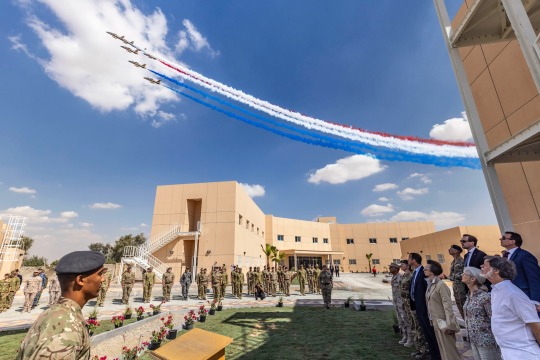
Her Royal Highness The Princess Royal has officially opened a permanent UK military facility on an air base in the United Arab Emirates (UAE).
The Princess Royal toured the brand-new Headquarters, accommodation and welfare facilities at Al Minhad Air Base (AMAB) alongside the Assistant Chief of the Defence Staff (Support Operations), Air Vice-Marshal Pratley. They were accompanied by Sir Hobart, His Majesty’s Ambassador to the UAE, and Brigadier General Al Ketbi, AMAB Commander.
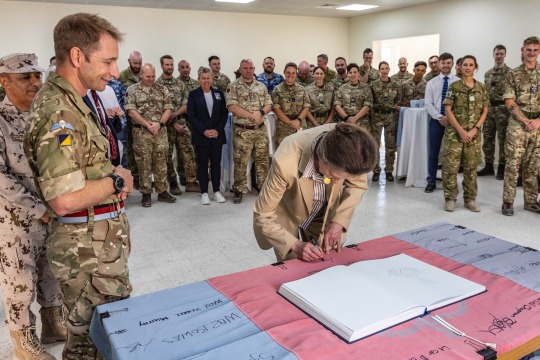
“I am delighted to attend the opening of Donnelly Lines, an essential part of the UK’s global footprint, and an example of our enduring presence overseas in what remains an uncertain world beset by turbulent times.
Our continued investment here is a further example of the UK’s commitment to the security of the region and is a tangible commitment to the work for peace, security, and stability, working hand in hand with our allies in the UAE.
The siting of Donnelly Lines at AMAB enables the UK to maintain our freedom of action and ability to conduct operations from the UAE, bolstering our operational resilience. It is of vital importance, and I recognise the hard work and stellar efforts of the team, who have, over several years, worked tirelessly around the clock to make this possible.”
- Air Vice-Marshal Pratley, Project Senior Responsible Officer
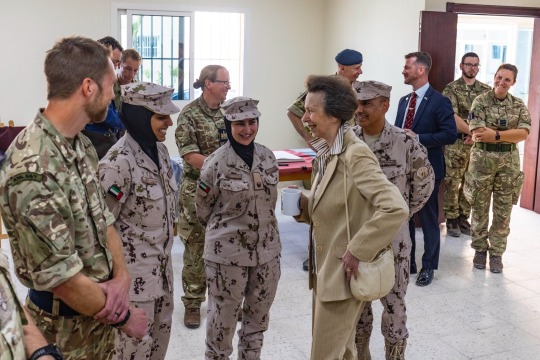
A joint UAE Air Force Al Fursan and RAF A400M flypast honoured the opening ceremony which included a coalition parade and a commemoration to the late Sergeant Donnelly, whom the Lines are named after.
The Princess Royal then met with Sergeant Donnelly’s family and coalition personnel based at AMAB where Her Royal Highness signed the legacy Joint Force Support flag that proudly flew over the base’s former UK Headquarters.
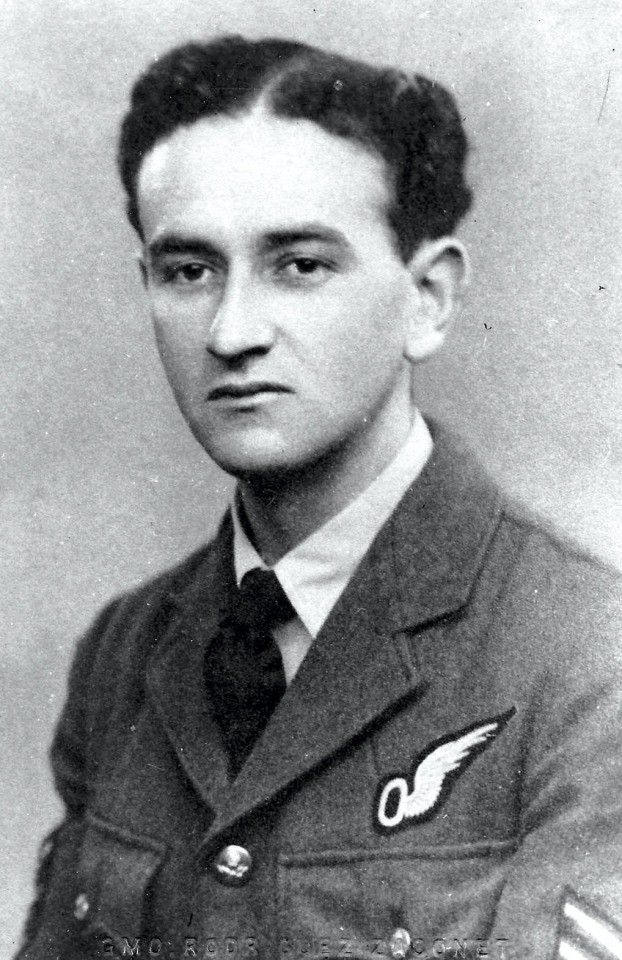
Sergeant William 'Billy' Donnelly.
Donnelly Lines is named after Sergeant ‘Billy’ Donnelly, an RAF Navigator who died in February 1943 after his Vickers Wellington Bomber crash landed in Fujairah, 75 miles east of AMAB. In 2010, a memorial was erected at the crash site, and now in 2024, this expansive facility in his name symbolises the longstanding ties between the UK and the UAE and the continued commitment to strengthening that relationship.
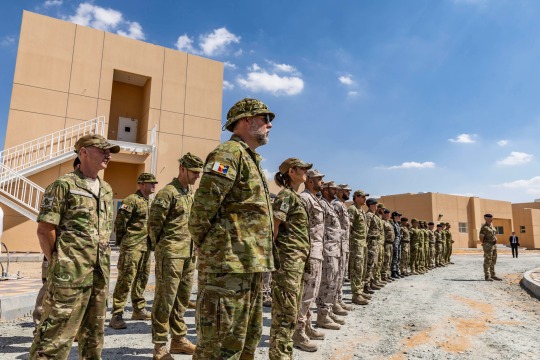
6 notes
·
View notes
Text
BRUSSELS, Nov 23 (Reuters) - NATO has warned its members that too much red tape is hindering troop movements across Europe, a problem that could cause major delays were a conflict with Russia to erupt.
"We are running out of time. What we don't get done in peacetime won't be ready in case of a crisis or a war," the chief of NATO's logistics command JSEC, Lieutenant-General Alexander Sollfrank, told Reuters in an interview published on Thursday.
NATO's Joint Support and Enabling Command (JSEC) in the southern German town of Ulm started operating in 2021. Its job is to coordinate the swift movement of troops and tanks across the continent as well as logistical preparations such as the storage of munitions on the alliance's eastern flank.
A result of Moscow's invasion of Ukraine in 2014, the creation of JSEC reflected the assessment that NATO, after decades of detente following the Cold War, once again needed to be ready for a war in Europe that could break out at any time.
However, the task of quickly deploying forces up to a size of a division with some 20,000 troops, as well as having ammunition, fuel, spare parts and provisions in place, has become trickier since the Cold War.
While NATO and Warsaw Pact troops in the past faced each other mainly in Germany, the alliance has since expanded some 1,000 kilometres (600 miles) to the east, multiplying the length of NATO's eastern flank to some 4,000 kilometres in total.
"The expanse of space, the fact that not all forces are forward-based - all this means that the alliance has to be quick in moving troops from their bases to the right spot on the eastern flank," Sollfrank noted, adding this needed preparation.
"At the heyday of the war in Ukraine, Russia fired 50,000 artillery shells per day. These rounds have to reach the howitzers," he said. "So you have to set up warehouses - for ammunition, fuel, spare parts and provisions."
As it is, NATO forces have to navigate a variety of national regulations, stretching from the advance-notice required before ammunition can be shipped to the permissible length of military convoys and disease prophylaxis.
"We have a surplus of regulations, but the one thing we don't have is time," warned Admiral Rob Bauer, head of NATO's military committee. "Russia's war against Ukraine has proven to be a war of attrition – and a war of attrition is a battle of logistics."
Sollfrank said he would like to see a "military Schengen", an area of free military passage akin to the political Schengen zone that allows free movement within most of the EU.
NATO must not prompt a miscalculation in the Kremlin by giving the impression Moscow might stand a chance to win because the alliance is not prepared, he warned.
"We need to be ahead of the curve. We have to prepare the theatre well before Article 5 has been invoked", he said, referring to NATO's collective defence clause which effectively puts the alliance at war.
2 notes
·
View notes
Text
Gravix Shards
Essence: Gravity, Weight, and Endurance
Gravix Shards are Aethrys crystals embodying the elemental and conceptual essence of gravity and weight. They grant hosts the ability to manipulate gravitational forces—enabling powers from localized flight and levitation to crushing pressure and enhanced physical resilience.
Appearance and Structure
Gravix Shards form dense, multifaceted crystal clusters that resemble dark metallic ores fused with translucent crystal.
Surfaces shimmer with an oily sheen, subtly bending light as if altering gravity itself
Common colors: deep graphite gray, gunmetal blue, with veins of iridescent black or dark green
Crystals grow in layered, plate-like formations or massive crystalline boulders
Larger shards emit a faint gravitational hum, felt as a low vibration
Clusters, known as Ironreach Fields, are primarily found in the Gravix Zone but can appear elsewhere via shardfall
Powers and Abilities
Hosts bonded with Gravix Shards command gravitational forces with these abilities:
Gravity Manipulation: Increase or decrease gravity’s pull on self, others, or objects
Flight and Levitation: Defy gravity to float or fly at will
Crushing Force: Focus gravity into localized crushing pressure, immobilizing or damaging foes
Enhanced Durability and Strength: Gravitational reinforcement grants increased physical resilience
Gravity Wells: Create zones of altered gravity to slow, trap, or control enemies
Power effectiveness scales with bond strength and user control.
Bonding Process and Manifestation
Gravix bonding often occurs during intense physical stress, endurance feats, or exposure to strong gravitational forces—such as deep cave exploration, high-altitude climbing, or combat.
Shards commonly embed near major joints or the spine to aid structural support
Crystalline growths may appear as plates or ridges on shoulders, forearms, or legs
Some hosts manifest subtle gravitational distortions around their bodies, perceived as heaviness or lightness by others
Initial bonding can cause intense pressure sensations, crushing pain, or disorientation as gravitational forces calibrate
Psychological and Biological Effects
The Gravix bond influences hosts both mentally and physically:
Tend toward grounded, stoic, and patient demeanors, reflecting gravity’s steadiness
Increased tolerance for pain and fatigue is common
Physically, hosts may develop denser muscles and thicker bones through shard influence
Extended use of gravitational powers risks vertigo, dizziness, or spatial disorientation
Compatibility and Rarity
Gravix Shards are drawn to those who bear heavy burdens or demonstrate resilience under pressure.
Compatible with stoic, disciplined, or burdened individuals enduring physical or emotional weight
Bonding often occurs during high-stress endurance, combat, or unique gravitational exposure
Rites involving endurance, pressure, or resistance to gravity improve bonding chances
Rarity:
Approximately 1.2% of the population bonds with Gravix Shards
Natural bonding: ~0.15%
Rite bonding: ~1.05%
Present in 12–13% of all bonded individuals
Communication and Sentience
Gravix Shards communicate through sensations of weight, pressure, and resistance.
They convey guidance via feelings of heaviness or lightness
Warn hosts of imbalance through gravitational fluctuations
Strained bonds may cause disorientation or unintended crushing effects
Notable Phenomena Related to Gravix Shards
Gravity Wells: Localized zones where gravity is intensified for defense or offense
Weight Shifts: Ability to transfer weight between objects or beings, enabling feats like effortless lifting or immobilization
Tethering: High-bond hosts can anchor themselves or others in space to resist movement or attacks
0 notes
Video
youtube
AUC3I - Daily Briefing 07-08-2025 On the WAR in Ukraine
Understanding The War In Europe _ Analyzing the situation on the ground with by way of an introduction, 3 points, and a conclusion #militaryanalysis #militaryoperations #modernwarfare
COMBAT BRIEFING NUMBER 1232 Combat Situation Report – 8 Jul 2025
1. Strategic Overview Russian joint forces maintained broad-front pressure, claiming cumulative Ukrainian losses of ≈1 305 personnel, 22 armored vehicles, 63 soft-skinned vehicles, 18 artillery systems, 13 EW stations and 17 ammunition depots over the past 24 hours. Deep-strike assets hit 133 rear-area energy and logistics nodes that support Kyiv’s defense industry, while air-defense elements intercepted four glide bombs, one HIMARS rocket and 202 UAVs.
2. Sector Breakdown "North (Sumy–Kharkiv):" Moscow’s forces improved positions around Novoivanovka and Kondratovka, destroying an EW node and an ammo dump. Engagements near Vovchansk and Gatishche hint at a continued effort to envelop Kharkiv’s northern approaches and force Ukrainian redeployments from the forward line.
"West (Kupyansk–Lyman):" Elimination of a Polish 155-mm “Krab” SP gun plus two U.S. counter-mobility HMMWVs underscores Russia’s focus on neutralizing precision-fires assets. Five destroyed depots and three EW stations further erode Ukrainian sensor-to-shooter chains in the Oskil corridor.
"South (Seversk–Chasiv Yar):" “Southern” grouping pressed along the Siverskyi Donets, striking clusters at Zvanovka and Chasiv Yar; loss of a second HMMWV and an EW site signals attrition of NATO-supplied enablers. Tightening control of high ground near Belaya Gora complicates Ukrainian lateral resupply into Chasiv Yar’s shrinking pocket.
"Center (Krasnoarmeysk Interior):" Russian troops registered the highest personnel toll—≈430—while advancing near Muravka, Udachnoye and Rodinskoye. The push threatens to fracture the E50 logistics spine that feeds western Donetsk defenses.
"East (Donetsk–Zaporizhia seam):" Steady gains at Voskresenka and Karl Marx extend Russian fire control over the M18 axis. Reported takedown of a Ukrainian tank suggests dwindling armored reserves in the sector.
"Dnipro (Zaporizhia–Kherson):" Precision fires destroyed eight EW nodes and six ammo depots around Kamenskoye and Antonovka—preparatory shaping indicative of potential amphibious or pontoon actions along the lower Dnipro later this summer.
3. Fires & Air Domain Operational-tactical aviation and missile troops struck gas-to-power facilities that backstop Kyiv’s defense plants, aiming to choke production of artillery shells and UAV components. Successive days of 200-plus UAV shoot-downs show Russian AD operators adapting to Ukrainian drone-swarm tactics, compressing the window for reconnaissance and strike coordination.
4. Operational Analysis & Implications "Attrition Economics:" Destruction of another Polish “Krab” and multiple HMMWVs illustrates a cost-exchange that favors Russian forces; replacing NATO kit is slower than fielding additional Russian artillery tubes or First-Person-View drones. "EW & C2 Degradation:" At least 13 EW stations eliminated in 24 hours reduce Ukraine’s jamming and drone-control reach, widening Russian strike corridors. "Industrial Targeting:" Repeated hits on energy infrastructure supporting the Ukrainian military-industrial complex foreshadow longer-term shortages in artillery ammunition and drone production, potentially curbing Kyiv’s ability to sustain high-tempo operations by winter. "Manpower Strain:" Daily Ukrainian personnel losses now consistently exceed the equivalent of a reinforced battalion per axis, pressuring Kyiv’s mobilization pipeline and unit rotation schedules.
5. Outlook Expect continued Russian probing toward Kupyansk rail junctions and methodical tightening around Chasiv Yar. Deep-strike focus on power grids and gas nodes suggests a campaign to impede factory output before autumn. Ukrainian command will likely divert scarce reserves to shore up the Sumy–Kharkiv axis, risking further thinning of Zaporizhia defenses.
#RussiaUkraineWar #MilitaryAnalysis #FrontlineUpdates #Sumy #Kupyansk #Donetsk #Zaporizhia #EW #OperationalBriefing
0 notes
Text

Two U.S. B-52 Bombers Make Historic First Deployment To Romania
On their way to Romania, the two strategic bombers were intercepted by Russian MiG-31 and MiG-29 aircraft.
David Cenciotti
B-52 Romania
A B-52H Stratofortress from the 20th Bomb Squadron, Barksdale Air Force Base, La., makes its initial landing at Mihail Kogălniceanu Air Base, Romania, in support of Bomber Task Force Deployment 24-4, July 21, 2024. (U.S. Air Force Photo by Senior Airman Seth Watson)
On Jul. 21, 2024, two B-52H Stratofortress aircraft from the U.S. Air Force’s 2nd Bomb Wing, stationed at Barksdale Air Force Base in Louisiana, landed at Mihail Kogalniceanu Airbase in Romania as part of Bomber Task Force 24-4.
The deployment was somehow spoiled by the presence of several KC-135 tankers from the 100th ARW (Air Refueling Wing) out of RAF Mildenhall, tracking online as they supported the BUFFs (Big Ugly Fat Fellow – as the B-52 is nicknamed among the pilots community) on their way to Romania.
In fact, the B-52s were escorted by Finnish Air Force F/A-18C Hornets and German Air Force Eurofighters over the Gulf of Finland.
During their flight over the Barents Sea, the B-52s, operating in international airspace in compliance with international law, were intercepted by two Russian aircraft around 8 a.m. Central European Time. Despite the interception, the B-52s maintained their flight path and continued their mission as planned, including integration exercises with NATO fighter jets, before landing at Mihail Kogalniceanu Air Base.
This is a translation of the statement released by the Russian MOD:
To identify an air target and prevent violation of the State Border of the Russian Federation, MiG-29 and MiG-31 fighters from the air defense forces on duty were scrambled into the air.
Russian fighter crews identified the aerial target as a pair of US Air Force B-52H strategic bombers.
As Russian fighters approached, American strategic bombers made a turn from the State Border of the Russian Federation.
Russian aircraft returned safely to their home airfields, and no violations of the State Border of the Russian Federation were allowed.
The flight of Russian fighters was carried out in strict accordance with international rules for the use of airspace over neutral waters and in compliance with safety measures.
As per standard BTF deployments, while in Europe, the strategic aircraft will operate as an Expeditionary Bomb Squadron (the 20th EBS in this case) engaging in joint operations with NATO Allies and other international partners to enhance capabilities and reinforce security commitments within the U.S. European Command’s jurisdiction.

A KC-135 Stratotanker from the 100th Air Refueling Wing, Royal Air Force Mildenhall, England, refuels a B-52H Stratofortress from the 2nd Bomb Wing, Barksdale Air Force Base, La., while escorted by a Finnish F/A-18C Hornet during Bomber Task Force deployment 24-4, July 21, 2024. (Courtesy Photo)
This deployment marks the first instance of U.S. strategic bombers operating from Romanian territory.
General James Hecker, commander of USAFE-AFAFRICA, emphasized the importance of being positioned to deliver a range of capabilities globally. He stated that Bomber Task Force missions provide valuable opportunities to improve agile combat employment tactics, techniques, and procedures. Hecker highlighted that these collaborative efforts with Allies enable U.S. forces to address current and future threats effectively.
According to the U.S. Air Force, regular deployments of U.S. strategic bombers underscore the U.S. commitment to NATO Allies and partners. These missions enhance dynamic force employment in the European theater, providing strategic assurance to Allies while deterring potential adversaries with operational unpredictability.

Two B-52H Stratofortresses from Barksdale Air Force Base, La., fly in formation with fighter jets from Romania and Finland as they arrive at Mihail Kogălniceanu Air Base, Romania, in support of Bomber Task Force Deployment 24-4, July 21, 2024. (U.S. Air Force Photo by Senior Airman Seth Watson)
Hecker further noted the U.S. dedication to working with NATO Allies and partners along the Eastern Flank to ensure combined skills and coordination necessary for regional safety, security, and stability. Regular strategic bomber deployments demonstrate the readiness and integration capabilities of the U.S. and NATO to deter threats and defend the Alliance.
The previous deployment, Bomber Task Force 24-3, saw four B-52H Stratofortress bombers assigned to the 69th Expeditionary Bomb Squadron from Minot Air Force Base, North Dakota, operate from RAF Fairford, UK, from May 20 to June 18 – 20 (the four aircraft returned home in pairs, two days apart).

A pair of B-52H Stratofortresses from Barksdale Air Force Base, La., fly in formation alongside Romanian and Finnish fighter jets as part of Bomber Task Force deployment 24-4, July 21, 2024. BTF 24-4 underpins the NATO alliance’s collective deterrence and commitment to defending the Euro-Atlantic region from hostile actions. (Courtesy Photo)
About David Cenciotti
David Cenciotti is a journalist based in Rome, Italy. He is the Founder and Editor of “The Aviationist”, one of the world’s most famous and read military aviation blogs. Since 1996, he has written for major worldwide magazines, including Air Forces Monthly, Combat Aircraft, and many others, covering aviation, defense, war, industry, intelligence, crime and cyberwar. He has reported from the U.S., Europe, Australia and Syria, and flown several combat planes with different air forces. He is a former 2nd Lt. of the Italian Air Force, a private pilot and a graduate in Computer Engineering. He has written five books and contributed to many more ones.
@TheAviationist.com
10 notes
·
View notes
Text
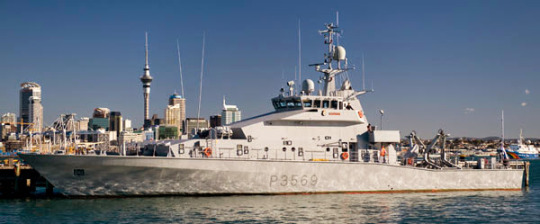
Navy checks on domestic fisheries fleet – HMNZS Taupo Navy, HMNZS Taupo, Devonport: Inshore Patrol Vessel (IPV) HMNZS Taupo on its delivery voyage from Whangarei to Devonport Navy Base, Auckland. Onboard was the Associate Defence Minister Hon Heather Roy. HMNZS Rotoiti sits infront of the Auckland Skyline. Inshore Patrol Vessel HMNZS Taupo has helped ensure fisheries compliance amongst the northern fishing fleet in a sustained boarding operation last month. 27 June, 2025 For three weeks, HMNZS Taupo patrolled from North Cape to East Cape, hailing commercial fishing vessels and getting Fisheries New Zealand Fishery Officers on board to conduct checks. Lieutenant Commander Toby Mara, Taupo’s Commanding Officer, estimated they covered the bulk of the northern fishing fleet, with 26 boardings undertaken. The Fishery Officers were checking the fishing vessels’ electronic reporting, paperwork and fishing practices. Pleasingly, a high degree of compliance was found. LTCDR Mara says they rotated two fisheries officers in each week. “It’s not always achievable for Fishery Officers to get to vessels off the coast, so this is where the Navy can help in getting them on board.” Fisheries New Zealand Director of Fisheries Compliance Steve Ham agrees. “Working with our partners at NZDF in a joint operation provides us greater capacity to inspect commercial fishing vessel operations at sea,” Steve Ham says. “This vital work enables us to gain a greater picture of fishing operations outside of territorial limits which we could not do without our support from NZDF.” Watch Checking on domestic fisheries fleet | Royal New Zealand Navy video Checking on domestic fisheries fleet | Royal New Zealand Navy Each day’s routine would start with a briefing on the bridge, with the Fisheries New Zealand Fishery Officers displaying their operating picture. Fishing vessels must report their location regularly, says LTCDR Mara. “We then hail the vessel by radio, but if they’re all on deck they may not respond immediately. If we don’t get a response, we’ll check with MPI about previous interactions, then go to boarding stations. The inspectors and our boarding party will go across in a RHIB and request to board.” He says the response from the crews is generally good. “This time, the vessels were generally compliant in their practice. There were a few minor issues, but nothing significant was found.” As well as the three-week operation, Taupo has training obligations for officers and sailors and is one of the fleet’s busiest ships. The ship cut short its schedule in the Bay of Plenty to avoid bad weather, expected swells to pick up to around the 4-metre mark. LTCDR Mara said that while the ship avoided the worst of it, the transit back north to Auckland was still rough. “The crew is well prepared for it,” he says. “What can get to people is the confined living, with shared cabins and a small amount of space. We often go into a port for a weekend, with the crew proceeding ashore for activities and a look-around.” He says he’s pleased with their latest time at sea. “After two days settling in, it went really smoothly. We’ll spend a week alongside in Auckland, prior to getting back out there and continuing with our programme.” “An Inshore Patrol Vessel’s programme can be pretty relentless, and we keep our bunks fill with sailors and officers who need sea training. A lot of people don’t realise how busy we can be.” Tags and categories: All RNZN/NZDF News Past and Present, Protector Class - Inshore Patrol Vessel -, Protector Class – Inshore Patrol Vessel – HMNZS Taupo (P3570) via WordPress https://ift.tt/wSX7Q3E June 28, 2025 at 11:34AM
0 notes
Text
10 Essential Navy Current Affairs for 2025
In an era where maritime dominance is a pillar of global strategy, naval affairs continue to influence geopolitics, defense investments, and international diplomacy. As 2025 unfolds, navies worldwide are facing complex challenges—from cyber warfare to humanitarian missions—requiring cutting-edge innovation and multilateral coordination.

Here are 10 Essential Navy Current Affairs for 2025, curated exclusively for TheVeza, offering a comprehensive look at the forces transforming the world’s oceans.
1. Rise of AI-Powered Naval Warfare
Artificial Intelligence is no longer the future—it’s the now. In 2025, navies globally are integrating AI for enhanced threat detection, autonomous navigation, predictive maintenance, and strategic decision-making. The U.S. Navy's Project Overwatch and the UK's Poseidon AI Framework stand out, aiming to fuse manned and unmanned systems into a cohesive combat network.
2. Expansion of Indo-Pacific Naval Alliances
Geopolitical tensions in the South China Sea have intensified, pushing countries like India, Japan, Australia, and the U.S. to strengthen the QUAD naval alliance. 2025 sees increased joint exercises such as Malabar 2025, focusing on interoperability, submarine detection, and freedom of navigation operations (FONOPs).
3. Green Fleets & Sustainable Naval Operations
Environmental responsibility is now a national security issue. The navies of Canada, Norway, and Germany are investing in hybrid-powered warships and adopting carbon-neutral port operations. The Green Ocean Naval Pact, signed in early 2025, marks a collective step towards reducing maritime carbon emissions.
4. Cyber Defense: The Fifth Naval Frontier
Naval assets are increasingly targets of cyber intrusions. In 2025, cyber warfare capabilities are being prioritized alongside traditional firepower. NATO has launched the Maritime Cyber Shield Initiative, aiming to build resilient digital defense mechanisms across allied fleets.
5. Submarine Warfare Renaissance
Silent but deadly, submarines continue to evolve. Russia and China are deploying next-gen stealth submarines, while the U.S. Navy expands its Virginia-class fleet. Meanwhile, the AUKUS pact introduces nuclear-powered submarine technologies to Australia, altering strategic balances in the Indo-Pacific.
6. Arctic Naval Expansion
As polar ice recedes, new shipping routes and resource hotspots emerge. In 2025, Arctic patrols and base constructions are increasing. The Arctic Maritime Defense Council, involving Canada, Norway, and the U.S., now conducts seasonal operations ensuring territorial integrity and environmental monitoring in the North.
7. Maritime Humanitarian Missions Surge
From disaster relief to refugee rescues, navy ships are increasingly deployed for non-combat missions. In 2025, operations like HUMWAVES in the Indian Ocean are delivering aid to cyclone-hit regions, showcasing the Navy’s humanitarian reach.
8. Digitization of Naval Training and Recruitment
Gone are the days of chalk-and-talk naval training. Augmented Reality (AR), Virtual Reality (VR), and AI simulations now dominate the training arenas. The Indian Navy’s DIGINAV 2.0 platform is setting new benchmarks for immersive, real-time decision-making skills development among recruits.
9. Private Defense Contractors in Naval Logistics
Private firms are playing a larger role in naval support services. From drone logistics to underwater surveillance, defense contractors like Lockheed Martin, BAE Systems, and Larsen & Toubro are building tech-enabled logistics vessels, reducing state burden while increasing efficiency.
10. Focus on Women in Naval Leadership
2025 marks significant milestones for women in the navy. The U.S. Navy appointed its first female combat fleet commander in the Pacific, while nations like India and the UK have expanded combat roles and onboard leadership positions for women. The Global Women in Navy (G-WIN) initiative has launched mentorship and skill-building programs across allied forces.
Final Thoughts
The tides of naval transformation in 2025 are powerful, multilayered, and deeply interconnected with global power dynamics. From deep-sea drone warfare to green energy battleships, the world’s navies are adapting to not just threats, but responsibilities that define the very idea of maritime dominance in a tech-first, climate-conscious, and increasingly unstable world.
As TheVeza continues to chronicle these shifts, staying informed of these 10 essential Navy current affairs for 2025 ensures you're always ahead of the strategic curve.
0 notes
Text
North America Electronic Warfare Market Leading Growth Drivers, Emerging Audience, Segments, Sales, Trends (2021-2028)
The North America electronic warfare market is expected to grow from US$ 5,941.90 million in 2021 to US$ 8,756.28 million by 2028; it is estimated to grow at a CAGR of 5.7% from 2021 to 2028.
North America Electronic Warfare Market Growth
Military operations are carried out in an electromagnetic (EM) environment that is becoming increasingly complex. Electronic Warfare (EW) is a military capability that supports all stages and parts of a military campaign and must be integrated into military vehicles and processes. This also helps in the planning and execution of joint operations, and it has become the primary means of fighting and winning wars. War's huge array of capabilities, skills, tactics, and organizations will devolve into chaos without careful planning to ensure interoperability, synchronization, and synergy. It is critical for a Commander to control the electromagnetic spectrum (EMS) to maintain the flexibility of action required to apply maximum fighting power at a specific point in the battle through holistic EMS planning, whether via dominance or control.
North America Electronic Warfare Market Strategies
Strategic insights for the North America Electronic Warfare market provide data-driven analysis of the industry landscape, including current trends, key players, and regional nuances. These insights offer actionable recommendations, enabling readers to differentiate themselves from competitors by identifying untapped segments or developing unique value propositions. Leveraging data analytics, these insights help industry players anticipate market shifts, whether investors, manufacturers, or other stakeholders. A future-oriented perspective is essential, helping stakeholders anticipate market shifts and position themselves for long-term success in this dynamic region. Ultimately, effective strategic insights empower readers to make informed decisions that drive profitability and achieve their business objectives within the market.
North America Electronic Warfare Market Insights
The geographic scope of the North America Electronic Warfare market refers to the specific areas in which a business operates and competes. Understanding local distinctions, such as diverse consumer preferences (e.g., demand for specific plug types or battery backup durations), varying economic conditions, and regulatory environments, is crucial for tailoring strategies to specific markets. Businesses can expand their reach by identifying underserved areas or adapting their offerings to meet local demands. A clear market focus allows for more effective resource allocation, targeted marketing campaigns, and better positioning against local competitors, ultimately driving growth in those targeted areas.
Download our Sample PDF Report
@ https://www.businessmarketinsights.com/sample/BMIRE00025369
North America Electronic Warfare Market Segmentation
The North America electronic warfare market is segmented on the basis of component, application, product type, and country. Based on component, the market is segmented into hardware, software, and services. The hardware segment dominated the market in 2020, and the market for the software segment is expected to grow at the fastest rate during the forecast period. Based on application, the North America electronic warfare market is segmented into electronic attack, electronic protection, and electronic warfare support. The electronic warfare support segment dominated the market in 2020, and the market for the electronic attack segment is expected to grow at the fastest rate during the forecast period. Based on product type, the North America electronic warfare market is segmented into countermeasure systems, jammers, sensor systems, weapons systems, and others. The sensor systems segment dominated the market in 2020, and the market for the countermeasure systems segment is expected to grow at the fastest rate during the forecast period. Based on country, the North America electronic warfare market is segmented into the US, Canada, and Mexico.
About Us:
Business Market Insights is a market research platform that provides subscription service for industry and company reports. Our research team has extensive professional expertise in domains such as Electronics & Semiconductor; Aerospace & Defense; Automotive & Transportation; Energy & Power; Healthcare; Manufacturing & Construction; Food & Beverages; Chemicals & Materials; and Technology, Media, & Telecommunications
0 notes
Text
DevOps for Managers: Leading the Change
One of the most overlooked challenges in DevOps adoption is the need for managers to adapt their leadership style. Traditional models often rely on top-down control, rigid hierarchies, and isolated decision-making. However, DevOps for Managers: Leading the Change requires a more flexible, people-centered approach.
Managers must move from command-and-control to coaching and enablement. That means trusting teams to make decisions, facilitating collaboration, and encouraging open dialogue between departments.
By shifting focus from control to empowerment, managers unlock team creativity, boost morale, and accelerate delivery.
Building a Culture That Supports DevOps
Culture is the foundation on which all DevOps practices are built. Even with the best tools and processes, DevOps fails without the right team mindset. That’s why DevOps for Managers: Leading the Change prioritizes psychological safety, accountability, and shared ownership.
Managers should focus on:
Encouraging experimentation and viewing failures as learning opportunities
Celebrating small wins that reinforce good practices
Setting a clear vision that connects DevOps goals with business outcomes
Creating open spaces for feedback and improvement discussions
A strong culture makes it easier for teams to collaborate, take initiative, and sustain momentum.
Aligning DevOps with Business Priorities
DevOps can’t exist in a vacuum. It must align with your organization’s broader goals, whether that’s customer satisfaction, faster delivery, or product innovation. As a manager, your role is to connect the dots between technical execution and business strategy.
DevOps for Managers: Leading the Change involves translating leadership objectives into meaningful metrics for engineering teams.
For example:
If your business wants to reduce churn, managers can prioritize incident response times and system uptime.
If speed to market is the focus, then delivery frequency and lead time should be your key metrics.
In this way, DevOps becomes more than a workflow—it becomes a business growth engine.
Encouraging Interdepartmental Collaboration
One of the main goals of DevOps is to eliminate barriers between departments. Still, many organizations struggle with internal silos that create delays, miscommunication, and duplicated work.
To address this, DevOps for Managers: Leading the Change calls for managers to be collaboration architects. This can be done by:
Holding joint planning sessions with Dev, Ops, QA, and Security
Defining shared KPIs across departments
Implementing communication channels that promote daily interaction
Assigning DevOps champions to coordinate between teams
When departments align under a unified DevOps vision, results are faster, smoother, and more reliable.
Managing Risk in a DevOps World
A common concern among managers is that faster releases may lead to higher risk. But in truth, DevOps reduces risk when implemented properly. With automation, real-time monitoring, and smaller, incremental changes, issues are identified and resolved quicker than ever.
As part of DevOps for Managers: Leading the Change, leaders must understand how to balance innovation with stability. This involves:
Setting guardrails instead of hard restrictions
Implementing approval workflows that don’t create bottlenecks
Supporting rollback options and feature toggles
Investing in observability tools to detect issues instantly
With the right risk strategies, DevOps becomes both fast and safe.
Training Teams for DevOps Readiness
Technology evolves quickly—and teams must evolve with it. Managers play a key role in upskilling their teams and preparing them for new responsibilities introduced by DevOps.
Your training strategy under DevOps for Managers: Leading the Change should include:
Hands-on workshops for CI/CD, automation tools, and cloud services
Soft skill development like problem-solving, communication, and agile thinking
Encouraging certifications in DevOps practices (AWS, Azure DevOps, etc.)
Regular knowledge-sharing sessions within and between teams
When managers invest in learning, it sends a message: DevOps isn’t just a tool shift—it’s a mindset upgrade.
Creating Accountability Without Micromanagement
As DevOps encourages autonomy, it’s crucial to maintain accountability without becoming overly controlling. Managers often struggle with this balance.
Here’s how DevOps for Managers: Leading the Change addresses this:
Establish clear performance indicators linked to outcomes, not tasks
Use dashboards and visual data to track progress transparently
Promote peer reviews and internal audits as part of the process
Trust teams to make decisions, while providing timely support when needed
This balance allows teams to grow while still delivering measurable business value.
Making DevOps Stick: Long-Term Sustainability
Initial enthusiasm for DevOps can fade without a clear long-term strategy. To ensure DevOps is embedded into your organization, you need continuous alignment, improvement, and leadership visibility.
Managers who succeed in DevOps for Managers: Leading the Change focus on sustainability by:
Scheduling regular DevOps health checks across departments
Encouraging retrospectives that lead to real action items
Keeping DevOps part of executive-level conversations
Refining KPIs as the company grows and evolves
DevOps is not a one-time project—it’s a long-term capability that should evolve with your business.
Final Message to Managers: Be a DevOps Leader, Not Just a Sponsor
The difference between companies that thrive with DevOps and those that don’t often comes down to one factor—leadership engagement.
DevOps for Managers: Leading the Change is a reminder that technology alone won’t transform your teams. It takes committed, informed, and growth-minded leaders to bring about real results.
So ask yourself:
Are you empowering your teams with the right tools and trust?
Are you aligning delivery practices with real business impact?
Are you actively removing roadblocks and enabling success?
If the answer is yes—you’re already leading the change.
SEO Meta Title:
DevOps for Managers: Leading the Change in Agile and Scalable Teams
SEO Meta Description:
Learn how DevOps for Managers: Leading the Change helps leaders drive faster releases, smarter collaboration, and stronger culture. A complete guide for DevOps leadership success.
Ready to Lead DevOps the Right Way?
You don’t need to be a developer to lead DevOps. You just need to be the kind of manager who sees potential, supports growth, and sets a clear direction.
📞 Need expert guidance to build a DevOps leadership strategy for your team? Let’s design a roadmap that fits your goals and your people.
0 notes